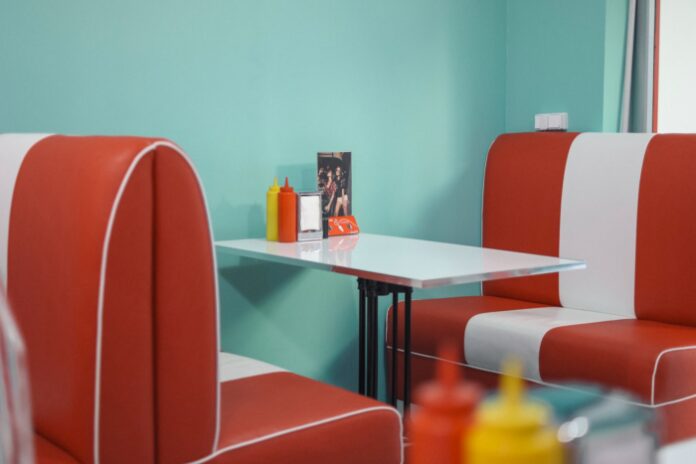In the ever-changing environment of restaurant design, the Retro Revival trend has developed as an engaging and enduring concept that transcends time. The charm of retro restaurant furniture, with its capacity to transport clients to bygone times, is critical in generating memorable dining experiences. This trend isn’t about copying; it’s an immersive journey into the core of design, where the essence of nostalgia pervades every piece.
In this investigation, we look deeply into the psychology of nostalgia, its tremendous impact on customer experiences, and the critical role that retro restaurant furniture plays in establishing the character of these enterprises. We will also explore the difficulties of acquiring, maintaining, and incorporating old artifacts, as well as the obstacles and ethical issues that come with embracing the timeless beauty of the past.
The Power of Nostalgia in Restaurant Design
Nostalgia is a powerful and widely understood feeling that has a tremendous impact on our decisions and perceptions. It ties us to beloved memories, elevating restaurant design above mere aesthetics to become an emotional connection. Restauranteurs create a mood that transcends ordinary aesthetics by tapping into the deep wellsprings of reminiscence. This emotional connection develops loyalty and a sense of belonging, giving customers the impression that they are returning to a beloved moment rather than simply dining out. Nostalgia is more than just a pretty face; it’s a psychological phenomenon that improves the customer experience.
The Retro Revival Trend
The Retro Revival style is a rich tapestry made up of threads from several eras. It does not focus on a single era but rather highlights the finest of all of them. From the glitzy Roaring Twenties to the simplicity and elegance of mid-century modernism, this trend gives new vitality to traditional design motifs. An increasing number of industries and businesses are capitalizing on the trend, recreating and reinterpreting iconic components to create a modern yet timeless allure. Vintage restaurant furniture is essential in replicating the atmosphere of bygone eras, giving authenticity and character that cannot be recreated.
The Allure of Vintage Restaurant Furniture
Vintage commercial-grade restaurant furniture has an inherent appeal derived from the craftsmanship of a bygone era. It’s not only the aged textures and faded colors; it’s the stories these items hold. Each chair or table is a vessel that has stood the test of time and has its own story. Including such items in restaurant design not only creates an environment, but also produces a sense of nostalgia and wonder in diners. Aside from aesthetics, vintage furniture provides versatility, allowing restaurateurs to create varied rooms that appeal to a wide range of customers. Furthermore, it adheres to ecological standards by reviving ancient items rather than adding to environmental stress.
Sourcing Vintage Restaurant Furniture
Finding authentic vintage pieces is an experience that necessitates a keen eye and a love of exploring. Estate sales and auctions frequently reveal hidden gems, providing a window into the past. The joy of discovering one-of-a-kind finds in thrift stores is unparalleled, yet unpredictable. Online markets and specialist dealers cater to a larger audience, making vintage pieces available to collectors all over the world. Reproduction and reinterpreted vintage furniture offer feasible solutions for customers seeking a mix between authenticity and affordability, allowing restaurateurs to generate a nostalgic ambiance without breaking the budget. These many sourcing channels enable restaurateurs to build one-of-a-kind places that capture the soul of the past.
Incorporating Vintage Furniture in Restaurant Design
Incorporating old furniture into restaurant design necessitates a careful mix of retro and modern aesthetics. It is critical to mix and match styles, experiment with colors and materials, and ensure utilitarian factors like comfort and ergonomics. Lighting is essential for highlighting vintage artifacts and boosting the overall feel. Personalization gives a touch of distinction, allowing restaurateurs to instill a feeling of individuality and character in their operations. Each design aspect, from seating arrangements to lighting fixtures, contributes to creating a unified and memorable ambiance for customers.
Maintaining and Caring for Vintage Furniture
The charm of old furniture necessitates attentive maintenance and attention. Regular cleaning, addressing wear and tear promptly, and investing in professional restoration services when necessary are all tips for extending the life of these pieces. Upholstery maintenance, in particular, necessitates delicate handling to maintain both aesthetics and hygiene. By following basic maintenance procedures, restaurateurs can ensure that their vintage furniture continues to enchant customers for years to come, safeguarding the investment value of these one-of-a-kind items.
Sustainability and Ethical Considerations
In the midst of the glamour of vintage furniture, it is critical to analyze its environmental and ethical implications. Sustainable approaches like upcycling and eco-friendly design reduce waste and put less burden on natural resources. Responsible vintage furniture utilization is aided by ethical sourcing procedures, transparent supply chains, and support for local artisans. By emphasizing these factors, restaurateurs can not only create visually appealing venues but also have a positive impact on the environment and local communities. The nostalgic features in restaurant design get depth and meaning through sustainability and ethical sourcing.
Challenges and Potential Drawbacks
While the appeal of vintage restaurant furniture cannot be denied, there are some obstacles to overcome. It is critical to balance nostalgia with functionality and comfort; guests should feel at ease while enjoying the ambiance. Hygiene considerations, particularly with upholstery, necessitate meticulous attention to ensure that vintage pieces satisfy modern hygiene requirements.
Maximizing space in vintage-style restaurants without sacrificing ambiance presents a unique problem that necessitates careful layout planning. Additional considerations for restaurateurs include durability, safety, and accessibility in order to provide a smooth dining experience for all patrons. Taking up the challenges adds levels of complexity and usefulness to the use of historic furniture in restaurant design.
Embracing the Timeless Allure
Vintage commercial restaurant furniture is a tribute to the enduring pull of nostalgia as the Retro Revival movement continues to enchant the culinary world. Restauranteurs may build environments that transcend time by studying the psychology of nostalgia, researching varied sourcing choices, and negotiating the obstacles and ethical considerations.
Embracing the timeless beauty of old furniture is more than just a design choice; it’s an invitation for diners to embark on a nostalgic journey, where the past and present seamlessly collide, producing remarkable dining experiences that stay in clients’ hearts and memories. The marriage of aesthetics, emotions, and functionality results in a symphony of components that characterize the restaurant of the future, steeped in nostalgia for the past.
FAQs
1. What is retro revival in restaurant design?
Retro revival in restaurant design is the use of vintage-inspired furniture, colors, and décor elements from past decades to create a nostalgic and emotionally engaging dining experience. It blends classic aesthetics with modern functionality.
2. Why is vintage restaurant furniture so popular?
Vintage restaurant furniture is popular because it adds character, authenticity, and emotional appeal. It tells a story, enhances ambiance, and helps restaurants stand out by creating memorable experiences that modern furniture often cannot replicate.
3. Where can restaurants source vintage furniture?
Restaurants can source vintage furniture from estate sales, auctions, thrift stores, antique dealers, online marketplaces, and specialized vintage furniture suppliers. Reproductions and reimagined vintage pieces are also common alternatives.
4. Is vintage restaurant furniture sustainable?
Yes, vintage furniture supports sustainability by promoting reuse and reducing waste. Upcycling and restoring old pieces lowers environmental impact and aligns with eco-conscious restaurant design practices.
5. What challenges come with using vintage furniture in restaurants?
Challenges include maintenance, hygiene standards, durability, comfort, and space optimization. Restaurateurs must balance nostalgic aesthetics with modern safety, accessibility, and functionality requirements.
Find a Home-Based Business to Start-Up >>> Hundreds of Business Listings.















































